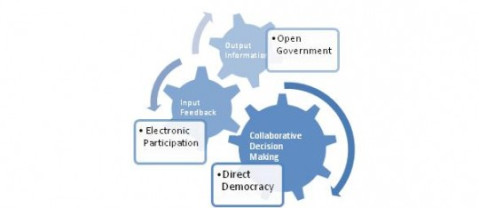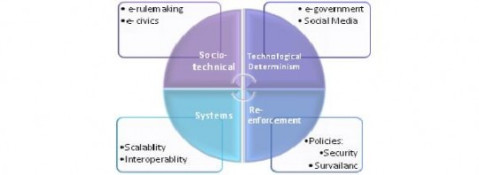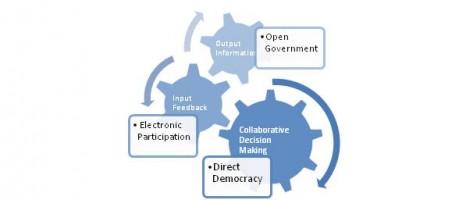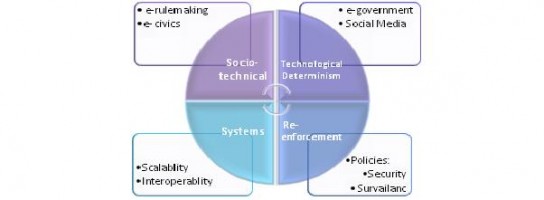Widgetized Section
Go to Admin » Appearance » Widgets » and move Gabfire Widget: Social into that MastheadOverlay zone
Open Governance: Engineering the Electronic Path to Participative Democracy
The views expressed are those of the author and do not necessarily reflect the views of ASPA as an organization.
By Parisa Haim Faridian
October 24, 2014
The practice and theory of public administration has seemingly come a long way from the eras dominated by the discussions on Weberian Iron Cage and Habermasian Communicative Rationality. The Internet has facilitated initiatives of electronic governance worldwide, igniting considerations on making direct democracy a reality through many layers of e-democracy, at the core of which lands electronic participation. Consequently, Rousseau’s once idealistic Social Contract may gain increasing viability by the virtue of the 21st century innovative electronic media and mediums which facilitate the society wide participative consensus on Public Goods through electronic deliberation.
Yet, the realization of a true participative democracy deems improbable in the absence of transparency, which is essential to a meaningful and effective participation of informed and educated citizens. The cage is broken, the communication is real time and yet the curtains are in the way. Indeed, a transparent and open government is detrimental to the triumph of e-participation.
The open transparent debate is not new to the governments’ agenda. It has adopted different forms and shapes reflective of the crisis and state of affairs of its time. Thus far, the realities of the politics and policy streams have inhibited the realization and implementation of a true form of open and transparent government, reducing it to a mere slogan in the practical eyes of public managers.
Presently, by the virtue of the Obama administration’s Open Government initiatives, more than ever the burden is placed on the public managers’ shoulders to swim irregular streams of politics and policy in a quest to inform, educate and ultimately elicit citizen participation in different levels of government decision making. These new initiatives have added new dimensions to the existing challenges of public managers in balancing information access, with security and privacy, surpassing the traditional objectives of transparency in pursuit of accountability, reliability and legitimacy.
The recent participative objectives warrant implementation of open governance as the stepping stone to a meaningful multi-way interactive system. Openness is no longer a matter of simple output of information. It requires engineering a system that provokes reaction to the outputs in form of practical inputs from stakeholders, collecting, organizing, analyzing and ultimately functionalizing these inputs throughout organizational decision making processes (Figure -1). Undoubtedly, engineering such a sophisticated system in such vast magnitude entails detailed, elaborative and rigorous planning and institutionalization constrained upon time, budget and clear scope. Additionally, administrators need to adopt a multi-faceted approach to designing such system; vigilant of a fourfold theoretical framework of information technology and social change pertaining: socio-technical, re-enforcement, technological determinism and systems aspects, identified by David Garson in his book Public information technology and e-governance: Managing the virtual state.
The socio-technical
perspective persuades public managers in innovating use of information and communication technology (ICT) by informing and engaging participative actions of stake holders and citizens in rule making and decision making. This view advocates initiatives aimed at e-participation, e-civics and e-rulemaking enabled through social media and other Web 2.0 collaborative features.
The re-enforcement theory cautions public managers of technology that aggravates the existing imbalances and inequalities in democratic participation, such as the digital divide and cultural hegemony, further strengthening the existing power structures. It also elucidates public managers’ challenges in surviving the constant state of flux caused by policy makers’ power on use of technology, evident in acts and reforms such as FOIA, reverse FOIA, EFOIA and HSA.
The technological determinism perspective reminds public managers of the organic self-governing nature of technological trends, evident in digital crisis attributable to whistle blowing websites (e.g., WikiLeaks), and crowdsourced social media on political and national events that go viral (e.g., Ben Ghazi), among others that need to be accepted and addressed as realities of today’s digital age. It also rationalizes the arguably inefficient investments of e-governance initiatives, e-participation included, as inevitable trend of the future, slowly transferring real world processes and practices to the virtual ones.
Lastly, the systems approach offers insight on engineering the infrastructure of the electronic, transparent, and participative democratic system of the future, bringing to the forefront the design elements such as interoperability, scalability, cybersecurity, IP rights, and viable investments defying rapid obsolescence of technology (Figure -2).
In response to the new open governance requirements, agencies started to publish their plans, addressing these objectives of transparency, collaboration and participations over the next two years. Many agencies addressed a variety of the aspects noted in above fourfold theoretical framework, including whistleblower protection and social media transparency channels. Nevertheless, what seem to be missing in these plans are initiatives to systematically gather, analyze, and functionalize citizens’ inputs in agency affairs.
Ostensibly, the new era of open governance and open governments is developing, with a purpose of increasing citizen participation in once sacred governance and administration affairs, and a promise of new form of democracy. The cage was broken. The communication is real time. The curtains are gradually disappearing. Yet, the path is to be designed.
Public administration is positioned at the center of challenges and opportunities of this new era. Empowered by the technological developments, and sighted in the light of open government objectives, public administration’s new quest in the age of electronic participation seems to be engineering the path to a more democratic future.
Author: Parisa Haim Faridian is a doctoral student in the school of public administration in Florida Atlantic University. Her research and teaching interests are e-governance, program evaluation, organizational theory, project design and public management.








 (2 votes, average: 4.00 out of 5)
(2 votes, average: 4.00 out of 5)
Follow Us!